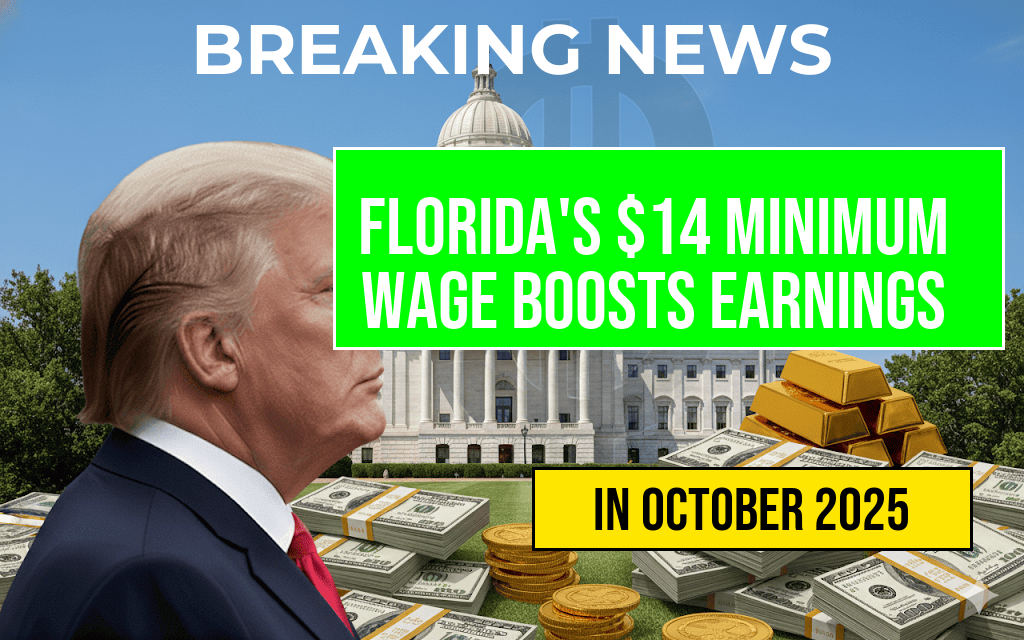Florida’s Minimum Wage Hikes to $14 Could Significantly Increase Earnings for Full-Time Workers
Florida’s decision to raise the minimum wage to $14 per hour by September 2024 is poised to reshape the income landscape for thousands of full-time employees across the state. Based on current employment figures and typical work hours, this increase could boost annual earnings by approximately $2,080 for full-time workers earning the minimum wage. This change comes amid ongoing debates over living wages, economic equity, and labor market recovery following the disruptions caused by the COVID-19 pandemic. The move aligns Florida with a broader national trend toward higher minimum wages, aiming to address the rising costs of living while balancing economic growth and business viability.
What the Wage Increase Means for Workers
The scheduled hike to $14 an hour reflects a significant step up from the previous minimum wage of $11.25, which was in effect until September 2023. The increase is part of a phased plan enacted through legislation passed by the Florida Legislature, designed to reach $15 per hour by 2026. The current adjustment to $14 represents a 24.4% increase over the prior rate, directly impacting millions of hourly workers in sectors like retail, hospitality, healthcare, and other service industries.
For a full-time employee working 40 hours weekly, the raise translates into a weekly increase of $60, totaling around $3,120 annually. However, considering that some workers may work slightly fewer hours or have variable schedules, the estimated annual boost of about $2,080 offers a realistic picture of the financial impact for many earning at or near the minimum wage.
Economic Implications and Broader Context
| Current Wage | New Wage | Weekly Increase | Annual Increase (approx.) |
|---|---|---|---|
| $11.25 | $14.00 | $60 | $2,480 |
While the direct benefit is clear for workers, economists and business leaders continue to debate the broader economic effects. Advocates argue that higher wages can reduce poverty, increase consumer spending, and improve overall quality of life. Conversely, some business groups worry that increased labor costs may lead to higher prices, reduced hiring, or automation in certain sectors.
Research from organizations such as the Wikipedia page on minimum wages indicates that modest increases often correlate with improved worker well-being without necessarily hampering employment levels, especially when implemented gradually. Florida’s phased approach aims to strike a balance, allowing businesses time to adjust while providing workers with a timely income boost.
Regional Variations and Cost of Living Factors
Florida’s diverse economy and regional differences influence how wage increases impact local communities. Urban centers like Miami, Orlando, and Tampa generally have higher living expenses, making wage hikes more immediately beneficial for workers in those areas. Conversely, rural parts of the state may experience less immediate economic pressure but will still see benefits from increased consumer purchasing power.
Data from the Florida Realtors suggests that housing costs, healthcare, and transportation remain primary drivers of financial strain for low-income households. Increasing the minimum wage aims to help bridge some of those gaps, although advocates emphasize that wage growth should be complemented by broader affordable housing and healthcare initiatives.
Industry Response and Future Outlook
Businesses across Florida have expressed mixed reactions. Smaller retail and hospitality firms warn about the increased payroll expenses, while others see the wage hike as an opportunity to attract and retain higher-quality staff. Larger corporations, often with more resources, tend to adapt more easily, but the change underscores the ongoing challenge of maintaining competitiveness in a rising wage environment.
Looking ahead, the phased increase to $15 per hour by 2026 aligns Florida with states like California and New York, which have already implemented higher minimum wages. Analysts anticipate that the policy will continue to influence labor market dynamics, potentially prompting further discussions about wage standards and economic equity across the nation.
Conclusion
The upcoming increase in Florida’s minimum wage to $14 per hour marks a pivotal step toward elevating income levels for countless full-time workers. While the immediate financial benefit for many will be an additional approximately $2,080 annually, the broader implications include potential shifts in consumer spending, business operations, and regional economic development. Policymakers and stakeholders will closely monitor the outcomes, shaping future debates on living wages and economic resilience in the Sunshine State.
Frequently Asked Questions
What is the new minimum wage in Florida?
The minimum wage in Florida will increase to $14 per hour.
When does the Florida minimum wage increase take effect?
The wage increase is set to take effect on October 1, 2023.
How will the wage increase affect full-time workers’ annual earnings?
The increase to $14 per hour could boost full-time workers’ annual earnings by approximately $2,080.
Which workers are impacted by the Florida minimum wage increase?
The increase primarily impacts full-time and part-time workers earning minimum wage across various industries in Florida.
Are there any future plans for minimum wage adjustments in Florida?
Yes, Florida has plans for scheduled future increases that will gradually raise the minimum wage to keep pace with inflation and cost of living.

Leave a Reply